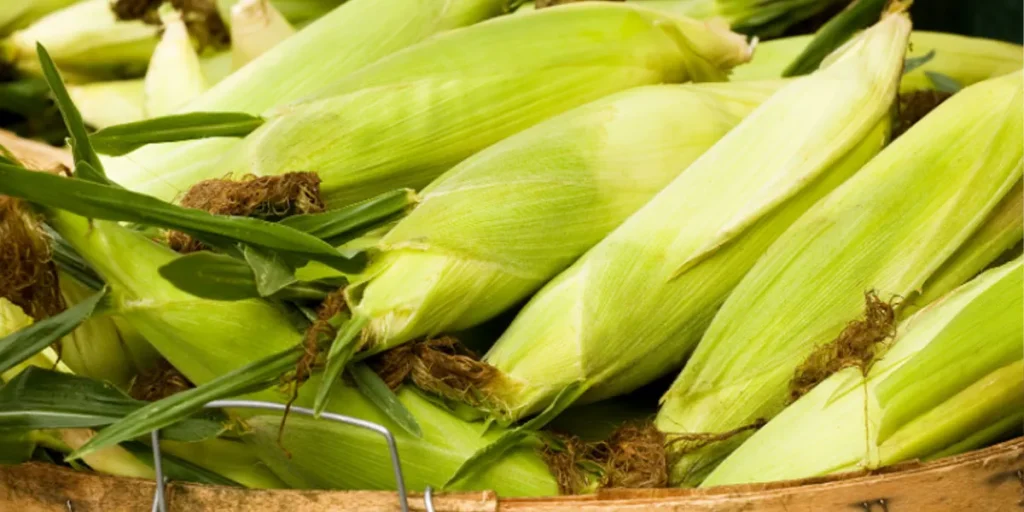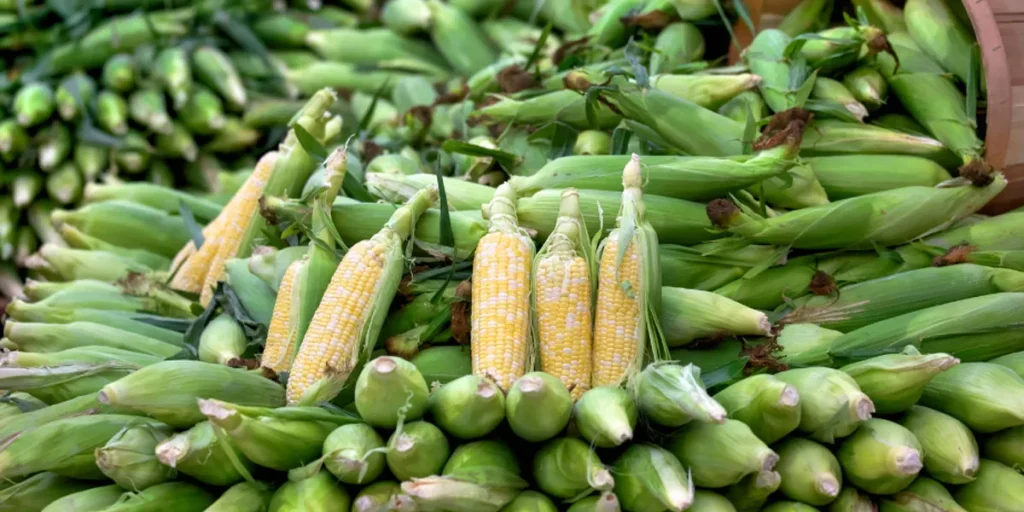A bushel of corn typically weighs 56 pounds. This standard measurement is widely used in agricultural practices.
Understanding the weight of a bushel of corn is crucial for farmers, traders, and buyers within the agricultural industry.
The bushel is a unit of volume that’s converted to a weight for commodity crops like corn. For anyone involved in the grain market, this conversion factor simplifies the trading and pricing processes.
Seasonal yields, market prices, and storage calculations all hinge on this essential figure. Perfect for those keeping a keen eye on agricultural trends, this weight conversion remains a staple in the agribusiness.
Knowing how much a bushel of corn weighs enables more accurate forecasting, budgeting, and strategic planning for all stakeholders in the supply chain.
Bushel Basics
When talking about farm products, one term often pops up: bushel. But what exactly does it mean?
A bushel is not just a quantity; it’s a whole story that spans agriculture’s history and continues in today’s modern farming practices.
Understanding this unit of measure helps us grasp the enormity of agricultural production and the weighty matters of corn trade and distribution.
Origins Of The Bushel
The story of the bushel starts centuries ago. It was a standard measurement in Old English times. People back then used it to sell crops at market.
The word ‘bushel’ itself comes from an old French word, bossele, meaning ‘a little sack’.
- Old English system: Basis of the bushel measurement.
- French influence: The term bushel originates from French language.
- Agricultural importance: Historically significant for crop trade.
Current Use In Agriculture
Jump to the present, and the bushel is more alive than ever in agriculture. It’s a key unit farmers and traders use to price grains, like corn.
The bushel’s weight can change based on the crop. Even so, for corn, a bushel usually weighs 56 pounds.
This measure comes in handy when buying or selling large quantities of this valuable grain.
| Crop | Standard Weight Per Bushel |
|---|---|
| Corn | 56 pounds |
| Wheat | 60 pounds |
| Soybeans | 60 pounds |
Today, bushels help maintain fair trade in the farming world. This old unit guides modern machines that harvest millions of acres of corn.
Thus, the bushel connects our past with the present, ensuring everyone gets a fair share.
Corn Measurements

Ever wondered about how much a bushel of corn weighs? A bushel is a volume unit. It’s a way to measure agricultural commodities like corn.
Yet, the weight of bushel varies. This section reveals key insights into the weights and measures of corn!
Volume Vs. Weight
Understanding corn volume versus weight is essential. A bushel equates to 35.24 liters in volume. But its weight can change.
This is due to moisture content and kernel size. Typically, a bushel of shelled corn is around 56 pounds.
Factors Affecting Corn Weight
- Moisture content: Higher moisture means heavier weight.
- Corn variety: Different types weigh differently.
- Test weight: This is the weight of corn without spaces between kernels.
Other factors include storage conditions and handling practices. Each can alter the weight of a bushel. Farmers and buyers keep these in mind when trading corn commodities.
| Factor | Impact on Weight |
|---|---|
| Moisture Content | More moisture increases weight |
| Corn Variety | Different varieties have different weights |
| Test Weight | Affects the standard weight measurement |
| Storage Conditions | Poor conditions can lead to weight loss |
| Handling Practices | Improper handling might increase waste and decrease weight |
Determining Corn Bushel Weight

Determining Corn Bushel Weight is vital for farmers, traders, and consumers alike. Understanding the precise weight helps in pricing, transportation, and storage.
Variances in moisture content and kernel density can affect the bushel weight, making accurate measurement crucial for all parties involved.
The Standard Weight Of A Corn Bushel
A bushel is a volume measurement but its weight can vary. Traditionally, a bushel of corn is standardized at 56 pounds.
This weight is a baseline for dry corn at 15.5% moisture content. Variations in these factors can lead to different weights, making frequent checks essential.
Weighing Methods In Practice
Different situations call for different weighing methods. Here are several common practices:
- On-Farm Scales: Farmers may use calibrated scales to weigh their corn in bulk.
- Grain Elevators: These facilities often have certified scales for trade-level accuracy.
- Moisture Meters: To ensure the standard moisture content, meters are used before weighing.
Accurate scales and consistent methods are essential to maintain fairness in corn trading.
Market Implications
Understanding how much a bushel of corn weighs directly ties into its market value. Farmers, traders, and investors all need to grasp these figures for buying, selling, and planning purposes.
Pricing Corn By The Bushel
When it comes to corn, a bushel is not just a volume measurement but also a weight benchmark for market transactions.
One bushel of corn typically weighs 56 pounds. However, the weight can vary slightly based on moisture content and test weight.
| Corn Measurement | Weight |
|---|---|
| 1 Bushel | 56 Pounds |
This standard allows buyers and sellers to price corn effectively. The market price per bushel can fluctuate, influenced by various factors such as supply, demand, and seasonal trends.
Impact On Farmers’ Revenue
Farmers’ earnings are closely tied to the weight of the corn in bushels. This metric determines how much product they can move and at what price. Several factors can impact this:
- Yield per acre: The amount of corn produced affects total bushel count.
- Market prices: Higher prices can mean more revenue per bushel.
- Crop quality: Superior quality can weigh more, leading to better pricing.
Keeping track of the weight of harvested corn allows farmers to predict their potential income and manage their crop sales strategically to optimize their revenue.
Beyond The Bushel
Ever wondered what lies ‘Beyond the Bushel’ when measuring corn? A bushel is not just a quaint term from olden days; it’s a pivotal unit in agriculture. Yet, there’s more to the story.
Alternative Measurement Units
The weight of a bushel of corn varies, but understanding other measures is key. Let’s explore these alternatives:
- Pounds (lbs): One bushel of corn roughly equals 56 lbs.
- Kilograms (kg): This correlates to about 25.4 kg.
- Tonnes: Large-scale transactions often use tonnes.
Global Standards And Conversions
Converting bushels to other units is standard practice worldwide. Here’s how it translates:
| Measurement | Equivalent to 1 Bushel of Corn |
|---|---|
| Pounds (lbs) | 56 lbs |
| Kilograms (kg) | 25.4 kg |
| Metric Tonnes (MT) | 0.0254 MT |
These conversions ensure consistency in trade and understanding across borders. Every region respects these standards for smooth commercial exchanges.
FAQs About the Weight of a Bushel of Corn
What Does A Bushel Of Corn Weigh?
A bushel of shelled corn typically weighs 56 pounds. The measure is based on a volume of approximately 1. 25 cubic feet. It’s a standard unit for trading grain commodities.
How Many Ears In A Bushel Of Corn?
There are about 70 to 90 ears of corn in a bushel. The exact number can vary based on ear size and kernel density.
Factors like variety and growing conditions influence these attributes.
Can Corn Bushel Weight Vary?
Yes, corn bushel weight can vary due to moisture content. Dry corn weighs consistently at 56 pounds per bushel.
Higher moisture corn can weigh more, altering the bushel’s standard weight.
How To Convert Bushels To Pounds For Corn?
To convert bushels to pounds for corn, multiply the number of bushels by 56.
For example, 5 bushels equal 280 pounds (5 bushels x 56 pounds/bushel).
Always use the standard weight of 56 pounds per bushel for dry corn.
Conclusion
Understanding the weight of a bushel of corn is integral for both producers and consumers. A standard bushel weighs approximately 56 pounds.
This knowledge aids in market assessments and informs purchasing decisions. Embrace this crucial measure to navigate the agricultural landscape with confidence.
Let’s ensure every bushel counts!
Resources:
https://www.ers.usda.gov/topics/crops/corn-and-other-feed-grains/
